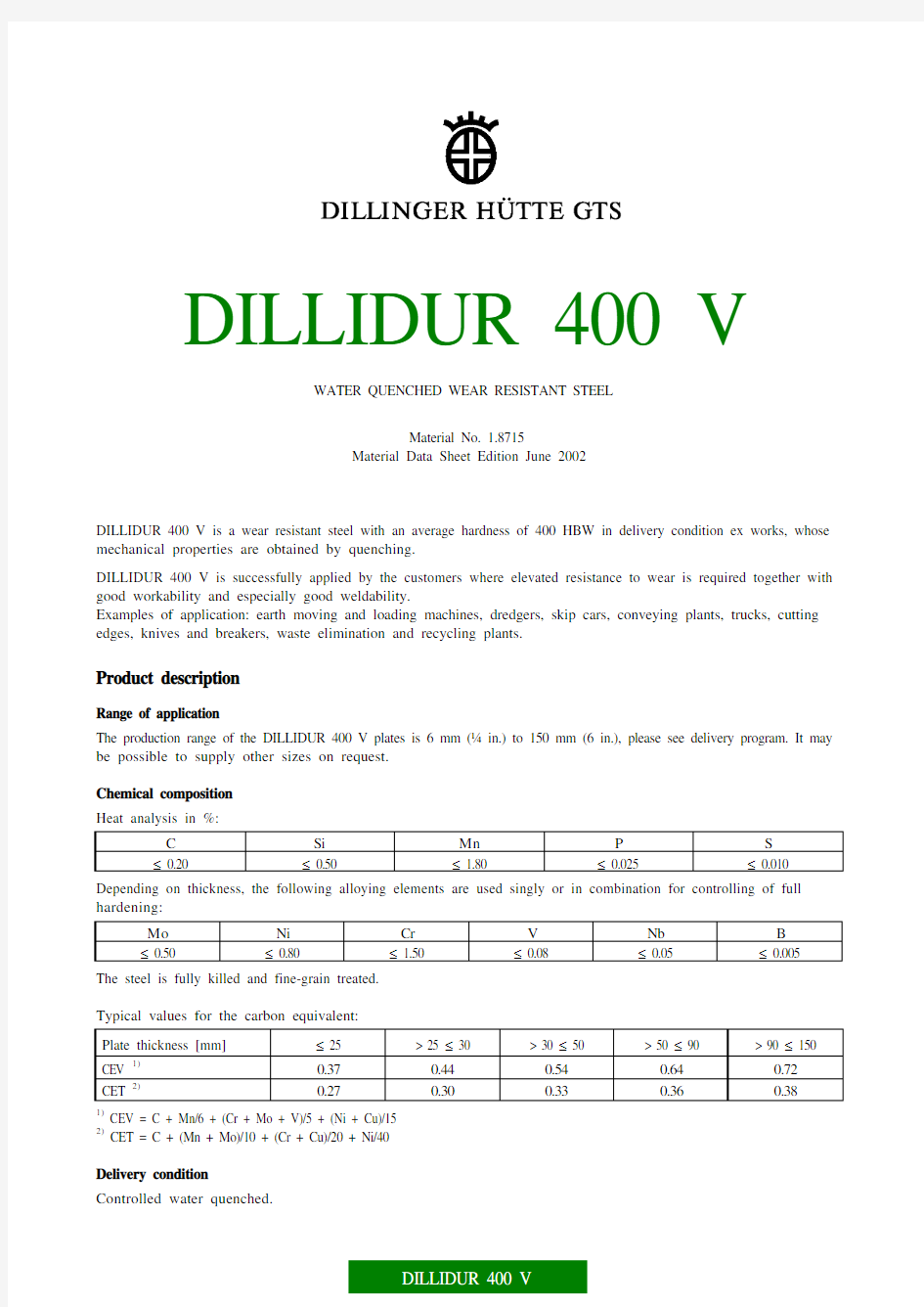Dillidur400


DILLIDUR 400 V
WATER QUENCHED WEAR RESISTANT STEEL
Material No. 1.8715
Material Data Sheet Edition June 2002
DILLIDUR 400 V is a wear resistant steel with an average hardness of 400 HBW in delivery condition ex works, whose mechanical properties are obtained by quenching.
DILLIDUR 400 V is successfully applied by the customers where elevated resistance to wear is required together with good workability and especially good weldability.
Examples of application: earth moving and loading machines, dredgers, skip cars, conveying plants, trucks, cutting edges, knives and breakers, waste elimination and recycling plants.
Product description
Range of application
The production range of the DILLIDUR 400 V plates is 6 mm (? in.) to 150 mm (6 in.), please see delivery program. It may be possible to supply other sizes on request.
Chemical composition
Heat analysis in %:
C Si Mn P S
≤ 0.20≤ 0.50≤ 1.80≤ 0.025≤ 0.010 Depending on thickness, the following alloying elements are used singly or in combination for controlling of full hardening:
Mo Ni Cr V Nb B
≤ 0.50≤ 0.80≤ 1.50≤ 0.08≤ 0.05≤ 0.005
The steel is fully killed and fine-grain treated.
Typical values for the carbon equivalent:
Plate thickness [mm]≤ 25> 25 ≤ 30> 30 ≤ 50> 50 ≤ 90> 90 ≤ 150 CEV 1)0.370.440.540.640.72
CET 2)0.270.300.330.360.38
1) CEV = C + Mn/6 + (Cr + Mo + V)/5 + (Ni + Cu)/15
2) CET = C + (Mn + Mo)/10 + (Cr + Cu)/20 + Ni/40
Delivery condition
Controlled water quenched.
Mechanical properties in the delivery condition
Hardness
Hardness at room temperature: 370 - 430 HBW
Tensile testing on transverse specimens at room temperature (typical values for 20 mm (0.8 in.) plate thickness) Tensile strength1300 MPa (190 ksi)
Yield point1000 MPa (145 ksi)
Elongation12 % (l o = 5.65√S o)
Charpy-V impact test on longitudinal specimens (typical values for 20 mm (0.8 in.) plate thickness)
Toughness30 J (22 ft·lbf) at -40 °C (-40 °F)
Bending test on transverse specimens (typical values for plate thicknesses up to 30 mm (1.2 in.))
Formability Radius of mandrel ≥ 2.0 x specimen thickness, bending angle 180°
Testing
Brinell surface hardness tested once per heat and 40 t.
Identification
The marking bears at least:
?the manufacturer’s brand
?the steel designation (DILLIDUR 400 V)
?the heat number
?the rolled plate number
Additionnally the plates are stenciled with the inscription DILLIDUR 400 V.
Workability
The entire fabrication and application techniques are of fundamental importance to the reliability of the products made from this steel. The fabricator should ensure that his calculation, design and fabricating methods are aligned with the material, correspond to the state-of-the-art that the fabricator has to comply with, and are suitable for the intended use. The customer is responsible for the selection of the material. The recommendations in accordance with EN 1011 should be observed while considering the higher strength and hardenability.
Cold forming
DILLIDUR 400 V can be cold formed in spite of its high degree of hardness. It should be paid attention to the fact that with increasing yield strength, the required forces for the forming operation also grow, even if the plate thickness remains unchanged. The backspring increases too. Grinding of the flame cut or sheared edges in the bending area is recommended to avoid cut crack initiation.
The cold forming operations should be carried out under consideration of the following recommendations (where t is the plate thickness):
Minimum bending radius Minimum die opening Transverse direction 3 t10 t
Longitudinal direction 4 t12 t
Hot forming
The steel obtains its hardness by accelerated cooling from the austenitizing temperature. After hot forming, the same hardness can only be obtained if the steel is quenched again after forming. It is to be expected that the hardness achieved through such a treatment differs from that measured in the delivery condition, because the cooling capacity available during plate manufacturing differs from that available in the fabricator’s works.
The steel may be heated to about 200 °C (390 °F) without any substantial drop in hardness.
Flame cutting and welding
For flame cutting, the following minimum preheating temperatures should be observed: 75 °C (170 °F) for plate thicknesses from 30 up to 50 mm and 100 °C (215 °F) for thicker plates.
